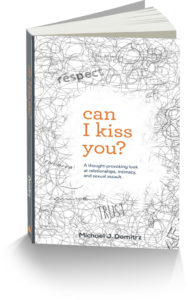Thank you for joining us here to continue the conversation from the book Can I Kiss You? A thought-provoking look at relationships, intimacy, and sexual assault written by Mike Domitrz.
As you scroll below, you will find the bonus sections for each chapter specifically written for Parents.
**If you can across the page accidentally, this is a special page devoted to Educators who are utilizing this book in their classrooms.
Chapter 1
3 extra questions to discuss with your students:
1. When has reading body language failed you?
2. Why did you assume what you assumed?
3. How could you avoid misreading body language in the future?
Chapter 2
Discover how to encourage all students of every demographic to speak out:
Create an exercise where everyone shares ideas for helping gain the confidence to speak out – both when you are comfortable and uncomfortable. Talk about how they could encourage each other at school to do so in the classroom and outside the classroom without falling into using stereotypical terms for being outspoken, passionate, and/or caring (an example could be “Why you being so soft?”).
Chapter 3
The “What If” exercise:
You have people write down their dating and/or relationship standards. Then people try to create “What if” questions to see how strong those standards are – while being respectful at the same time.
Example: a student’s standard is “I don’t kiss on the first date” and then other students ask:
- “What if you are super attracted to the person?”
- “What if you find out your date is interested in you and someone else you are competitive with? Would you kiss the date to insure they remember you more?”
- “What if your friend offered to you $20 to kiss the person?”
Often values start to change as “What If” questions are asked. This is a helpful discovery for students to create realistic standards and to know their potential triggers for not making the best choices.
Chapter 4
Consent is Ongoing.
At an age appropriate level, talk about how TO TALK during sexual intimacy. You could use kissing as a great example. Remove the fear of talking and the unhealthy stigma that talking “ruins the moment.”
Chapter 5
The “Blame Game”
Over the course of 3 days, have students create a point system in which every time they catch someone in the media (including paper, print, online) or entertainment world (including music, video, film, etc…) contributing to a victim blaming society, they write it down and gain 10 points. Bring the class together to share all the ways they caught victim blaming over the course of 3 days.
Talk about the devastating consequences those who engage in victim blaming can cause throughout society. Be sure to conclude asking for ways you could engage someone who is victim blaming to help them realize the impact and stop future victim blaming.
Chapter 6
What about the survivor in a classroom?
How would your students talk differently if they knew someone in the classroom was a survivor? As an educator, are you keeping in mind that there is a good chance you have multiple survivors in your classroom during the conversations and are you helping to create a safe, respectful environment for everyone?
Chapter 7
“What Is In Here?” Exercise
Have students write down on small pieces of paper every item that could be in a purse and/or around you in a bedroom, living room, basement, or any places two people could choose to be alone on a date together or in a situation involving sexual activity.
Collect the pieces of paper and put them into a bag. Pass the bag around having each student take out a sheet of paper and read the item that is on the piece of paper. Have the person and/or the room discuss how that item could be potentially be helpful for creating separation from a partner in a moment that they feel scared, worried, or fearful.
Stress that there is no 100% success rate for self-defense. At the same time, having options can be very helpful. Always conclude talking about the fact that only an assailant is responsible for a sexual assault.
Chapter 8
The “NO WAY” Activity
What are breaches of your standards and/or likes that you’d want to say, “NO WAY” to a date if they did and/or requested? Answers could range from going to a horror movie to a partner requesting a sexual act you do not want to participate in. Students do not need to name specific sexual acts. Keep the activity age appropriate and within your school standards.
Would you say, “No Way” to your partner? Why or Why not?
Chapter 9
The HEARD – SEEN – DONE Exercise.
TV, the entertainment world, and the media often refer to certain sexual activities among teenagers that are not actually happening frequently. Sadly, some teens incorrectly believe what they are HEARING about is extremely common and thus they are more likely to experiment with what could be high-risk and/or unhealthy sexual experimentation.
What would be a reason a friend would exaggerate about sexual experiences? How do you help the person stop the exaggerations?
What are fads or trends you’ve heard about in shows, movies, music and/or online that you think happen super rarely – if at all among your friends? Students can answer these questions on cards without their names for the exercise to be less embarrassing.
Chapter 10
To help deepen the lessons being taught in your classroom and to get the messages school-wide, bring Mike Domitrz to present the “SAFER Choices” program for your student body. Click here to learn more or call us at 800-329-9390.
Watch this quick 5-minute preview video of the “SAFER Choices” Student Assembly below.

